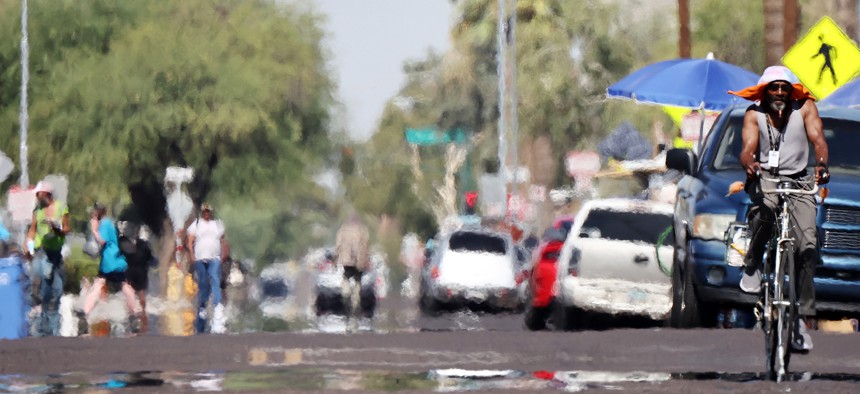Transportation is feeling the heat

A cyclist and pedestrians in the 'The Zone,' Phoenix's largest homeless encampment, amid the city's worst heat wave on record on July 25, 2023. Mario Tama/Getty Images
As cities nationwide get hotter, addressing extreme temperatures and their effects on roads, bridges and rail is becoming a priority.
The pavement in Phoenix was at times this summer hot enough to fry an egg on. Just this past weekend, the Arizona capital reached a record 55th day of temperatures above 110 degrees. It has been the hottest and driest summer on record. But if an approach to create “cool pavements” works, not only won’t it be possible to cook an egg on the city’s roadways anymore, but those roadways also won’t be as likely to buckle in the extreme heat.
Cool pavements is just one of a number of approaches that David Hondula, director of Phoenix’s Office of Heat Response and Mitigation, is testing in an effort to address the impact high temperatures are having on the city’s transportation systems. Hondula testified Wednesday before the Senate Environment and Public Works Committee that he wants those approaches to be models for other local governments.
“All across the country, local governments like ours have begun to recognize that there are serious deficiencies in planning for, mitigating and managing extreme heat,” he said.
As cities nationwide get hotter, addressing increasing heat is becoming a priority. The Senate committee hearing was aimed at highlighting the importance of the issue.
“Extreme heat can impact our transportation infrastructure in many ways,” said Sen. Tom Carper of Delaware, the committee’s chairman. “For example, when temperatures reach triple digits, roadways can buckle,” he said, noting that according to estimates, extreme heat could cost the nation $26 billion to maintain and replace roads by 2040.
Billions of dollars passed in the Infrastructure Investment and Jobs and the Inflation Reduction acts can help state and local governments offset some of these costs.
The infrastructure act, for instance, makes available an annual grant through fiscal year 2026 to increase surface transportation resilience through Promoting Resilient Operations for Transformative, Efficient, and Cost-saving Transportation, or PROTECT. It also provides $500 million in grants over five years for the Healthy Streets Program, which can pay for planting trees along streets in order to deal with “shade deserts” like in Phoenix.
Hondula’s office was created just two years ago to deal with rising temperatures and is in the “early stages” of figuring out how to mitigate heat’s effects on its roads and bridges.
An approach like cool pavements could be one solution, he testified. By applying a coating on asphalt to reflect more sunlight, “the temperature you would feel if you put your hand directly on it has been reduced by up to 12 degrees,” he said. “With this reduction, the underlying asphalt itself experiences less thermal strain. So the coating may reduce long-term asphalt maintenance needs and costs.”
But Hondula also cautioned that Phoenix and other cities are “learning as we go” and are still unsure about what “tradeoffs there might be.” For instance, he acknowledged seeing headlines on local news sites like, “Cool pavements make people hotter.” A street that reflects more heat, he said, could mean that “a person who is standing directly above it on the road surface when the sun is out might experience more heat stress.”
And there are a number of key issues that many state and local governments have not yet addressed, like protecting transportation workers working outside from the heat or educating staff on ways they can mitigate the effects of heat.
Travis Parsons, director of occupational safety and health for the Laborers International Union of North America, testified that states should be doing more to protect workers from the heat. Some states have passed protections, like a requirement in Washington that employers with outdoor workers provide cold drinking water, shade and a 10-minute break every two hours when the temperature is hotter than 89 degrees.
“Tragically, low-income workers and workers of color bear the brunt,” Parsons said. “Some may argue that providing additional rest breaks increases payroll expenses for employers. However, safer working conditions mean fewer injuries and illnesses resulting in lower health care costs, reduced workers comp claims and less lost time from work.”
Ultimately, he added, “the right to a safe workplace is a fundamental human right, and exposure to excessive heat is one of the most pressing hazards facing workers today.”
Training for staff on how to incorporate heat resilience planning into transportation projects is needed, said Aimee Flannery, global principal for transportation risk and resilience for the consulting firm Jacobs, Solutions & Technologies, which is working with several state transportation departments to develop resilience plans.
“I went to school, really 30 years ago. I was not taught about climate resilience,” she said. “So we have a whole bunch of practitioners 30 years out of school who have never heard these concepts.”
Professional organizations are offering training, she said. “But it's going to take a bit for it to make its way down to the layers of staff and those that can actually impact resilience.”
Federal agencies like the National Oceanic and Atmospheric Administration could also provide more training for state and local government workers to increase “heat literacy at the local level,” suggested Hondula. “I think we're still very much in the early stages of learning what it means to build heat-resilient communities.”
Kery Murakami is a senior reporter for Route Fifty, covering Congress and federal policy. He can be reached at kmurakami@govexec.com. Follow @Kery_Murakami
NEXT STORY: What Arizona and other drought-ridden states can learn from Israel’s pioneering water strategy






